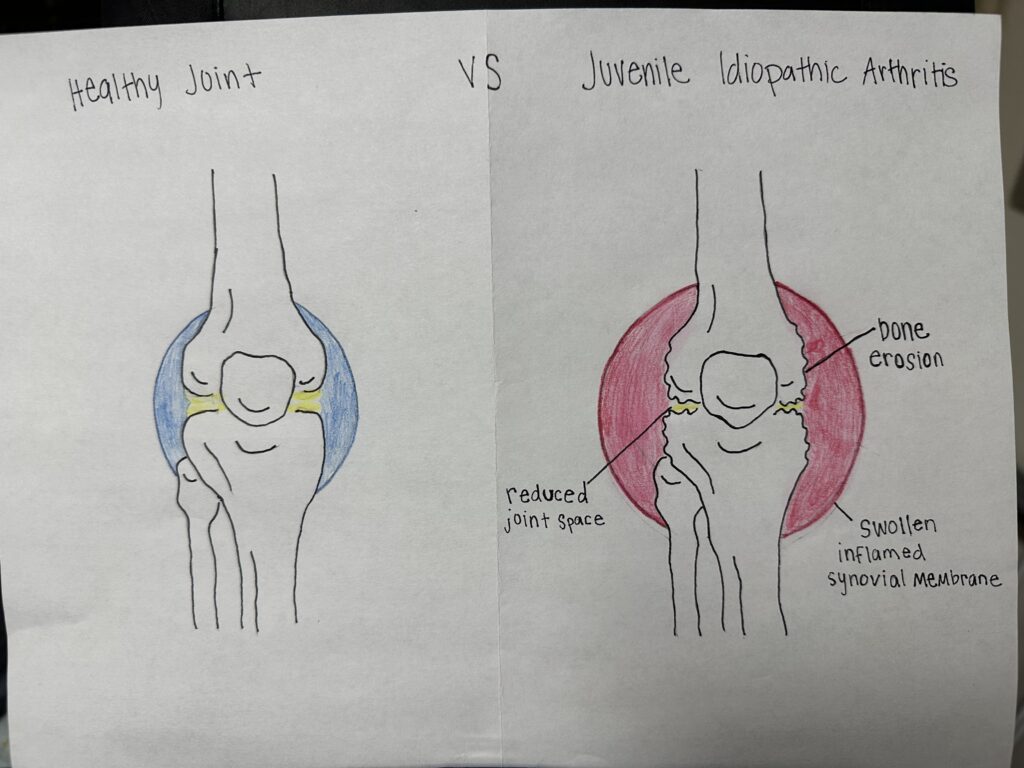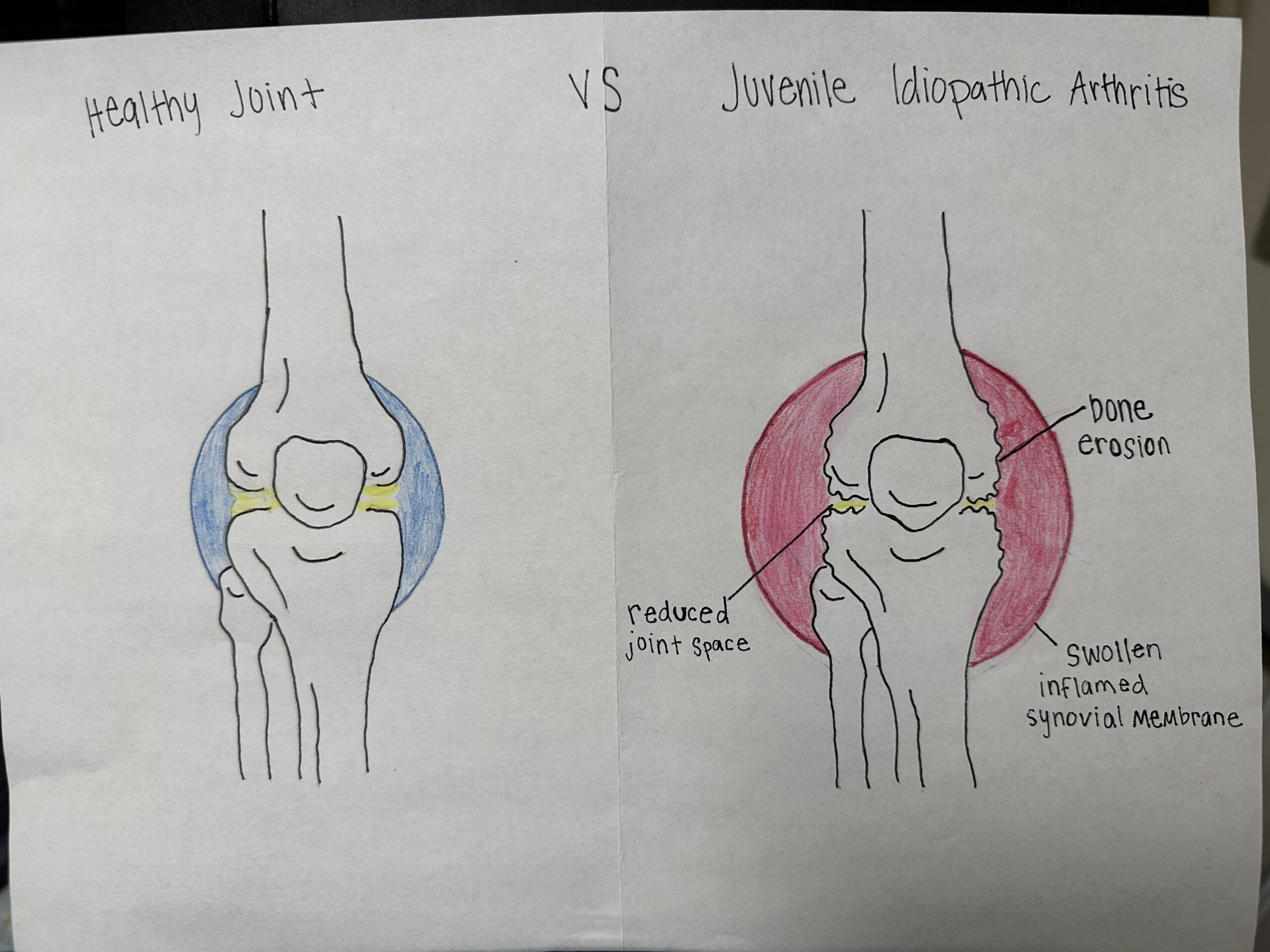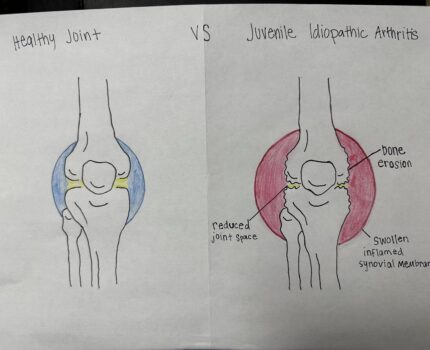
My project is about juvenile idiopathic arthritis. This falls under the objectives of knowing the stages of bone development and repair and knowing the structure of the knee joint and comparing this joint type to the other 5 joint types. My art piece is comparing and contracting a knee joint that is affected by juvenile idiopathic arthritis and a healthy, non affected joint. I choose this topic because it has been prevalent in my family in the past year. My youngest brother, Dane, is six years old. About a year ago he started complaining about his right ankle hurting. We are a very active family, so aches and pains from a hike or a long day snowboarding is common. But this one was different, Dane didn’t let up. His ankle was red, tender to the touch, and causing him to limp. We tried everything at home to get his ankle to feel better at home but nothing helped. We were at a loss so the next step was doctors. My mom took him to countless doctors and no one could quite figure out what was wrong with him. Finally he was referred to a specialist at Children’s Hospital and there he was diagnosed with juvenile idiopathic arthritis. No one in my family could wrap their head around that diagnosis. Juvenile idiopathic arthritis is “a broad term that describes a clinically heterogeneous group of arthritides of unknown cause, which begin before 16 years of age. This term encompasses several disease categories, each of which has distinct presentation, clinical manifestations, and, presumably, genetic background and etiopathogenesis.” (Giancane, G., Consolaro, A., Lanni, S. et al. 2016). For Dane the arthritis was mainly affecting his right side. It started in his ankle, moved up to his hip, and now there is a bit in his elbow and it has possibly jumped to his left side. In the beginning we were all worried about being too rough and hurting him even more. Most of the time he was limping everywhere but he wanted to keep up with the older kids so he pushed on. Since he was diagnosed he has been on a few different medications trying to find the best one for him. Currently he has a weekly methotrexate (a type of chemotherapy) shot and a handful of pills daily to combat the side effects of the chemo. Within the last month or two he has also been diagnosed with uveitis in his left eye as a result of the arthritis. Uveitis is a condition “that affects the iris and ciliary body and can cause severe visual impairment”. (Ravelli & Martini 2007). From this project and the last year or so I have learned that Juvenile Idiopathic Arthritis can be a hard condition to diagnose because it covers so many specific arthritides. It can affect just one joint or many many joints in the body. Along with joint pain Juvenile Idiopathic Arthritis can bring eye inflammation, fatigue, swollen lymph nodes, decreased appetite and weight loss, and high fever and or rash. I have learned that even with this diagnosis kids can live happy full lives just like my brother Dane.
References
Ravelli, A., & Martini, A. (2007, March 1). Juvenile idiopathic arthritis. The Lancet. Retrieved November 8, 2022, from https://www.sciencedirect.com/science/article/pii/S0140673607603638?via%3Dihub
Giancane, G., Consolaro, A., Lanni, S. et al. Juvenile Idiopathic Arthritis: Diagnosis and Treatment. Rheumatol Ther 3, 187–207 (2016). https://doi.org/10.1007/s40744-016-0040-4
Minden, K., Niewerth, M., Listing, J., Biedermann, T., Bollow, M., Schöntube, M., & Zink, A. (2002). Long-term outcome in patients with juvenile idiopathic arthritis. Arthritis & Rheumatism, 46(9), 2392–2401. https://doi.org/10.1002/art.10444


Juvenile Idiopathic arthritis is a broad description of various arthrides which occur before sixteen years of age, and can be difficult to diagnose. The effects of this type of arthritis are a good way to look at bone development and repair, especially when these natural processes are interrupted or go awry. As you can see a healthy join takes up its designated amount of space meaning surrounding tissues don’t have excess pressure on them and the bones don’t come in direct contact with one another, in the case of an arthritic joint the joint space reduces causing the bones to grind together and breakdown. While the mechanisms behind these arthrides are unknown we can still use them to look at and compare different joints. Because the symptoms are more likely to be related to injury at these young ages the condition is harder to diagnose, but once diagnosed the patient’s quality of life can begin improving.